We are halfway through August and it wont be long until we are turning some peanuts over and then defoliating some cotton. With that being said, our annual Southeastern Gin Harvest Meeting has been set. See the flyer below for details on that. Disease pressure has start to ramp up a bit in some peanut fields after all the rain last week, and with the warm temperatures this week we are in perfect conditions for white mold. I would start leaning to some more aggressive fungicide approaches to finish out the season, Bob has more to say on that and other diseases in his update. Cotton Jassids are still out and about, I am seeing very few damaging populations in Appling County though but stay on the lookout. We have a little more information on that pest, I have shared some slides with you from Dr. Roberts in this newsletter. We will have even more information next week as we have put in a Cotton Jassid Insecticide Efficacy trial in Appling County this week. Also, keep an eye out on the tropics, they are saying Erin will track away from us, North West of the coast, I hope so.
Topics In this Newsletter
- Southeastern Gin Harvest Meeting
- Variety maturity and size guide (Dr. Scott Monfort, UGA Peanut Agronomist)
- Row Crop Disease Update (Dr. Bob Kemerait, UGA Plant Pathologist)
- Cotton Jassid (Dr. Phillip Roberts)
- Finalizing Cotton Irrigation (Dr. Wes Porter, Precision Ag/Irrigation Specialist)
- Tropical Storm Erin formed, headed west, not likely to affect the US but stay tuned (Pam Knox, UGA Climatologist)
- All About the Pod Podcast (UGA Peanut Team)
- August Cotton Team Newsletter (UGA Cotton Team)
Southeastern Gin Harvest Meeting
Variety maturity and size guide (Dr. Scott Monfort, UGA Peanut Agronomist)
This is a Variety maturity and size guide that I wanted to share. This is just a guide as weather can alter both size and maturity. Thanks to Jennifer Miller for helping putting this together.
Row Crop Disease Update (Dr. Bob Kemerait, UGA Plant Pathologist)
Late Leaf Spot of Peanut

Note small dark spots with rough, dark sporulation on the undersides of the leaves. Late leaf spot. And the weather we have in Georgia now is perfect for infection and spread and delays in application of fungicides. Leaf spot is loose in Georgia’s peanut fields. Get after it.
White Mold of Peanut vs False White Mold

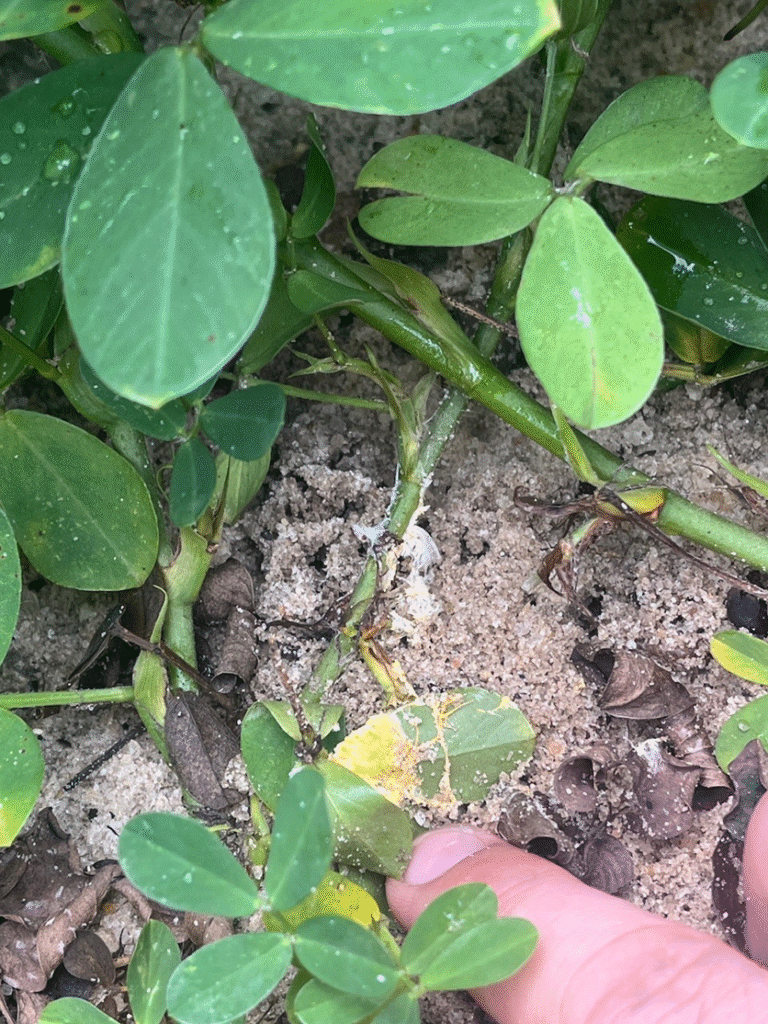
The first pic is genuine “white mold” and can cause significant damage if not effectively managed with a fungicide program. Note that these are small, contained “hits” of white mold. This means the program is working. Care should be taken to ensure that the white mold stays contained. The second pic is excellent picture of “false white mold” (fungus Phanerochaete). Though it can look threatening, be assured that false white mold (no lesions, as fungus ages it turns yellow-orange and toothed in appearance) causes no harm.
Pod Rot caused by Underground White Mold of Peanut
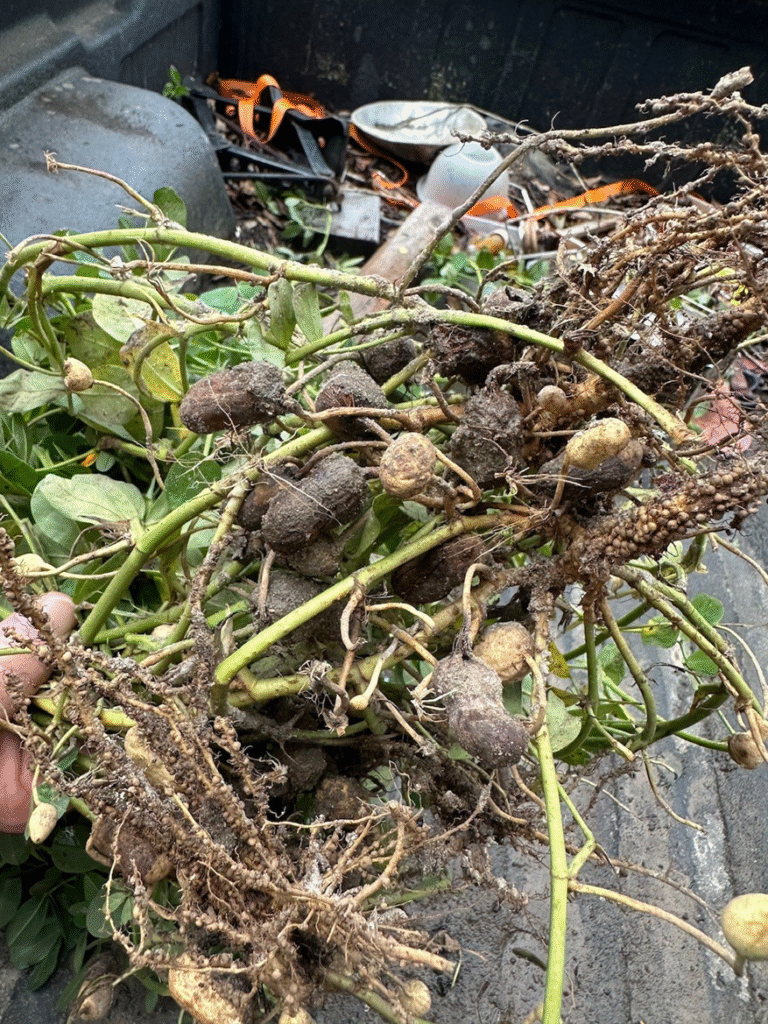
Soft-rotted pods with hint of shredded pegs. I asked him if the pods, when broken, had a bad odor. He replied immediately that they smelled terrible. It is a sickening smell. This is pod rot caused by “underground white mold” which is most serious in non-irrigated fields without water to move fungicides to crown of the plant.
Aerial Rhizoctonia of Peanut
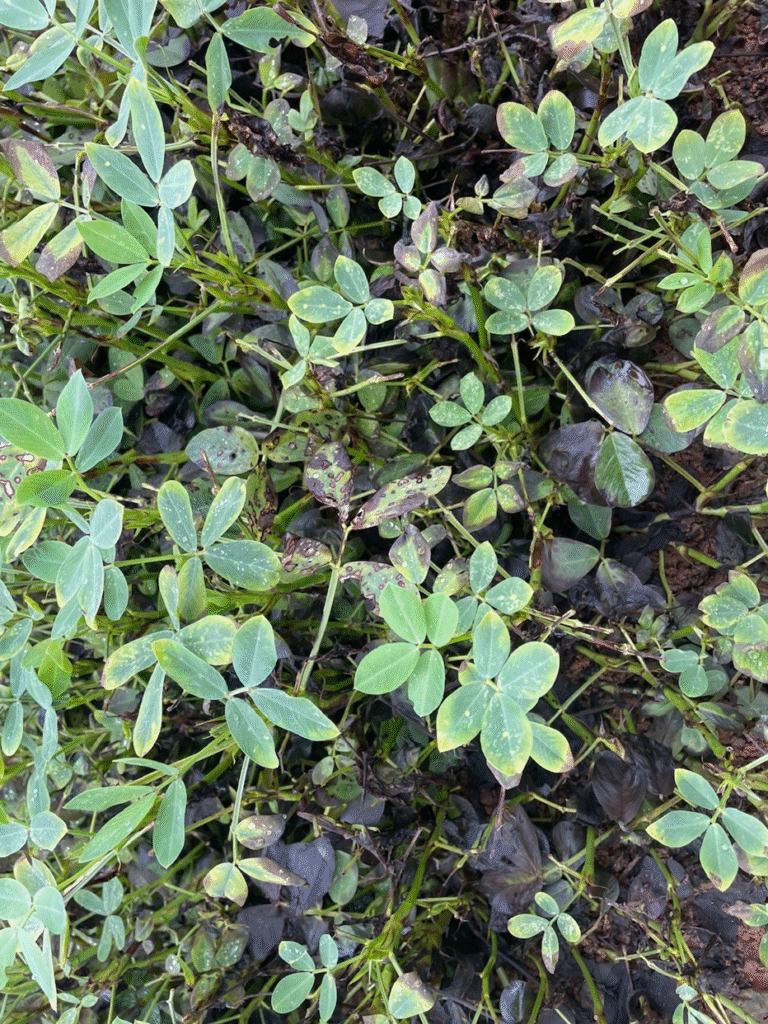
Aerial Rhizictinia on peanut, as bad as I have ever seen. Greasy lesions and a lot of defoliation. Favored by this weather. Azoxystrobin in one form or another (to include premix) is a good choice when rhizoc is a threat or when 12Y is planted.
Early Leaf Spot of Peanut
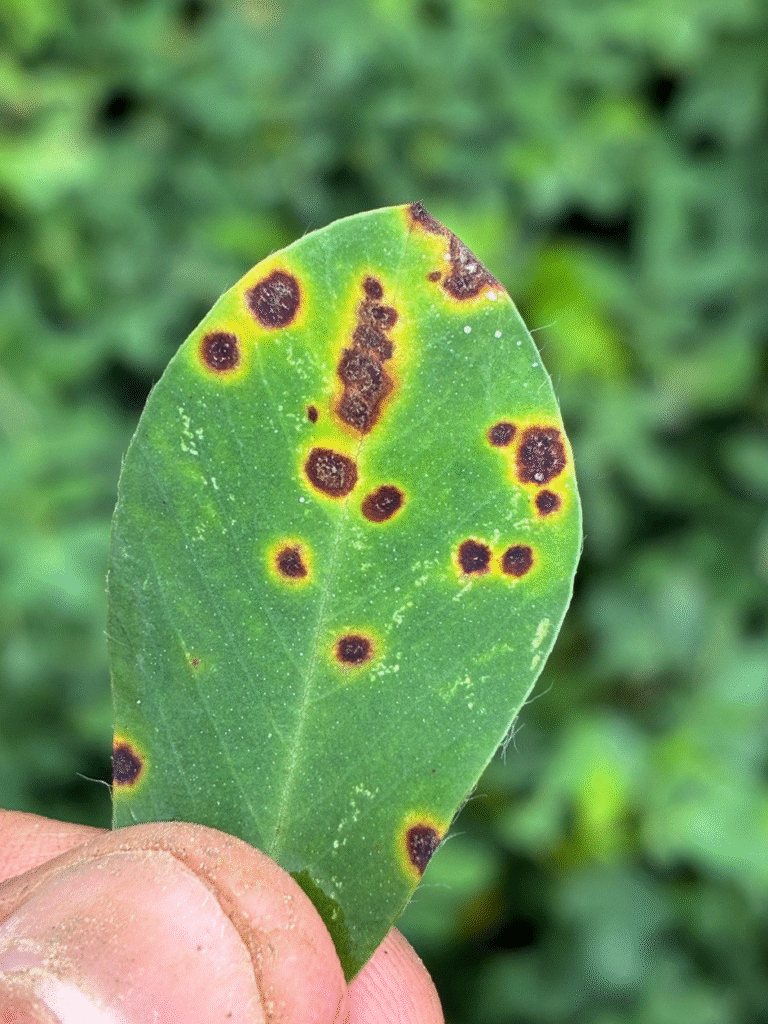
Note the brown spots with yellow halos with profuse sporulation on the top of the leaflet
Southern Corn Rust in Late Planted Corn
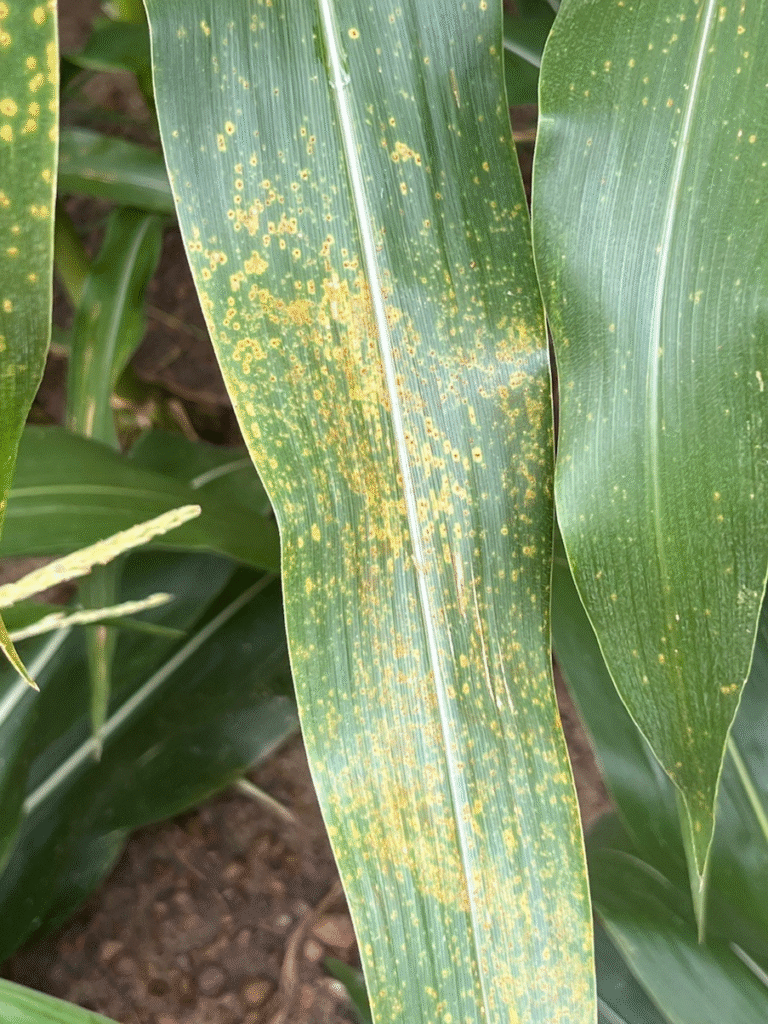
Late planted corn, eastern GA, no fungicide yet and corn at blister stage. This much rust at R2 blister stage means there will be yield loss to rust in this field. Late-planted corn should be treated with a fungicide at tassel.
Areolate Mildew of Cotton
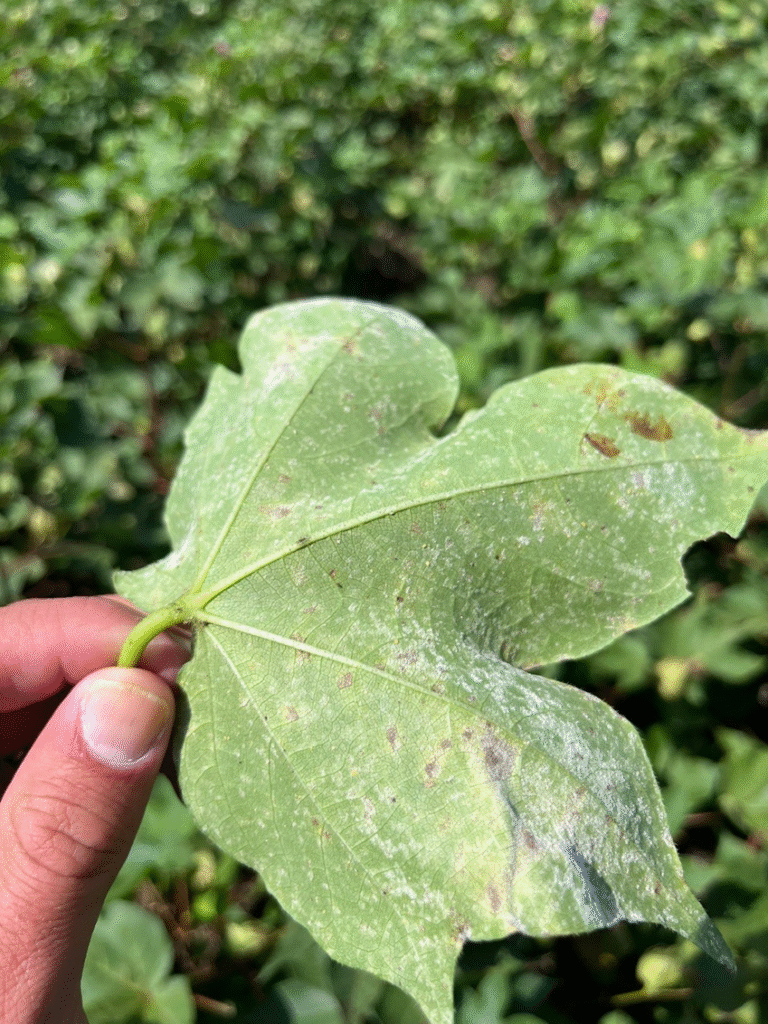
Take Home Message: Weather is perfect now for Areolate mildew and the disease is present in cotton and peanuts in SW and SE districts. Priaxor and Miravis Top are our most effective options. Not every cotton grower needs to spray, but every cotton grower needs to be aware of the potential risk and threat.
Diplodia Boll Rot of Cotton
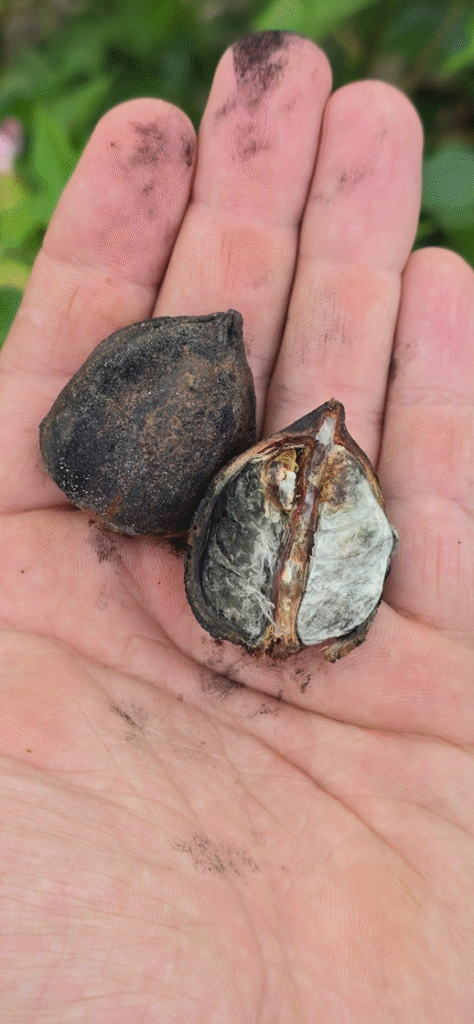
Boll Rot- the disease I can’t fix, especially in weather like this. Almost certainly this is Diplodia Boll Rot, note the beaucoup black and sooty spores on Jeremy’s hand. I wish there was something we could do, but in weather like this it is awful.
Cotton Jassid (Dr. Phillip Roberts)



Finalizing Cotton Irrigation (Dr. Wes Porter, Precision Ag/Irrigation Specialist)
The new Extension Precision Ag and Irrigation Blog post can be found at Finalizing Cotton Irrigation | Extension Precision Ag and Irrigation. Since we are moving through the season rapidly and I wanted to get you information in plenty of time, this week’s post is focused on finalizing irrigation for cotton. If you have any questions, please feel free to reach out and let me know.
Tropical Storm Erin formed, headed west, not likely to affect the US but stay tuned (Pam Knox, UGA Climatologist)
After Invest 97 formed over the weekend, it developed into Tropical Storm Erin on Monday, August 14, in the eastern Atlantic Ocean. It is currently moving over a relatively cool ocean and is interacting with some Saharan dust but it is expected to move over more favorable conditions in the next few days and is predicted to become a major hurricane by this weekend, when it is expected to track north of Puerto Rico on Sunday. After that, most of the hurricane forecast models indicate it is likely to turn to the north, which will keep it away from land (except perhaps Bermuda).
However, if Erin stay weak, it is less likely to make the turn to the north, and could head in a more northwesterly direction that could bring it closer to the US. There are just a few models indicating this possibility at the moment (less than 5 percent), but they have been trending a little bit south and west over the day, so it is too early to absolutely rule out any impacts, although the likelihood of any issues remains very small at this point. There is still plenty of time to watch the storm move westward and develop before any concerns or actions are necessary, it is just something to watch at this point. Don’t let social media posts showing a single model hurricane hitting the US scare you, because this is just one of a hundred other model tracks and the rest of them show something much different. In the next model run, the hurricane could be in a completely different place or nowhere at all.
After Erin moves through, the tropics look quiet for several days but there are some new waves moving west across Africa that have the potential to turn into tropical systems once they get over water. We are approaching the peak of the Atlantic hurricane season on September 10, but there is a lot of the season still to come after that and NOAA reiterated on August 7 that they think an above-average number of named storms is likely this year, so there should be plenty to watch in the next few months.

All About the Pod Podcast (UGA Peanut Team)
EPISODE 24, Season 3
In this episode, Scott Monfort, Eric Prostko, Scott Tubbs, Wes Porter, Taylor Singleton, Nino Brown (Peanut Breeder), David Bertioli (Peanut Breeder), Leo Bastos (Integrative Precision Agriculture), Camp Hand (Cotton Agronomist), and Gary Hawkins (Water Resource Management) discussed the current crop situation, current peanut breeding efforts, several integrative precision ag projects, and the importance and current issues with computer AI technologies. If you have any questions or would like to suggest topics for discussion on a future episode, contact your local UGA Extension agent.
August Cotton Team Newsletter (UGA Cotton Team)